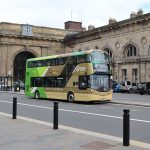Edinburgh operator Lothian Buses will place its 42 high-capacity Alexander Dennis Enviro400XLBs into service in March. The Volvo-based buses form part of its ambitious Bus2020 environmental strategy

Lothian Buses has finished talking about reducing its environmental impact, and instead it has made a firm start to acting on it. The most visible part of that will soon be 42 Alexander Dennis (ADL) Enviro400XLB-bodied Volvo B8L double-deckers, which are to enter service in the Scottish capital in March.
Much is known already about the tri-axle Enviro400XLBs. They seat 100 passengers and carry a further 29 standees; they also have an internal specification that ADL Chief Executive Colin Robertson accepts was “challenging” to satisfy.
From an operational perspective, they have significant advantages. Experience in other applications of the D8K engine that powers it leaves Volvo confident that the B8L will be more fuel efficient than earlier double-deckers with just two axles, and they will thus allow Lothian’s PVR to be reduced via the removal of peak-only workings.
To illustrate the potential impact that one Enviro400XLB can have on congestion, on Sunday 3 February Lothian posed a new tri-axle next to 100 cars. While that could be viewed as a stunt, its main purpose was to launch the operator’s Bus2020 strategy.
That will involve Lothian complying with the Scottish Government’s target of a 42% cut in greenhouse gas emissions, and it has mandated a £78m investment in the municipal operator’s fleet between 2016 and 2020. But it’s not just about vehicles. Much else is entwined with Bus2020 that, if actioned, could further improve public transport’s credentials in Edinburgh.
Euro 5 and Euro 6
As part of work to reduce its environmental impact, Lothian is committed to operating only buses that meet Euro 5 or Euro 6 emissions standards by the end of next year. A small number of vehicles will receive retrofitted exhaust aftertreatment equipment as part of that plan, but most of the task will be accomplished by the delivery of new and modern second-hand stock.
Lothian remains tight-lipped on whether more Enviro400XLBs will follow. Managing Director Richard Hall says it expects to release information on further bus orders soon, and he does not subscribe to the use of widespread retrofit of older stock to reduce emissions.
“We don’t see any value in retrofitting buses that are pre-Euro 5,” he says. “The engine technology is old. The vehicle is old. It can be refurbished, but it is still an unattractive bus that does nothing to encourage people to use public transport.”
While the operating side of the industry may – as Lothian has – expect vehicle manufacturers to work collaboratively with it to deliver products that have increased passenger appeal, Richard adds that buyers in return have an obligation to those suppliers.
“How can we demand a custom chassis and body product if we give builders no continuity?” he asks.
That message is backed up by ADL. Colin points out that a small percentage drop in car production volumes in 2018 has been portrayed as being a major problem. In 2016, the UK bus market saw registrations slump by 35%. That was “horrible,” he says.
“To deliver high-quality, innovative vehicles, there must be certainty.”
Smarter, not harder
Lothian is committed to the environmental agenda. Although it is yet to decide which routes the Enviro400XLBs will be used on, Richard explains that they will be targeted at services that currently require additional resource at peak times. Those vehicles sit idle for the remainder of the day, whereas the Enviro400XLBs have sufficient capacity to satisfy rush hour demand while not increasing operating costs at other times.
“That will be beneficial in a number of ways,” he says. “It will allow us to ‘flatten’ our bus graphs, and it will also be good for drivers. Removal of peak extras will reduce the number of split shifts that are required.” The tri-axles’ high capacity also means that emissions per passenger kilometre will be much lower than for a two-axle bus.
Volvo has no immediate plans for a hybrid variant of the B8L, or for a zero-emission example; like the other parties involved in the Enviro400XLB’s conception, it acknowledges that diesel at Euro 6 is the best all-round option for cost-effective emissions reduction.
The problem with that is perception. “The message has never got through to politicians; they don’t see diesel or diesel-electric hybrid as the answer,” says Richard.
“Full electric buses will never be a total solution. They cost a lot to buy, and there is the environmental impact of their batteries.” He adds that range anxiety remains an issue and that Lothian’s fleet size would have to increase if electric propulsion was adopted as standard.
The industry must polish its communications strategy if political and public momentum towards zero-emission is to be headed off, he continues.
Challenge and opportunity
Lothian is more fortunate in its relations with politicians as far as tackling car use is concerned. Although imposing restrictions or financial disincentives to discourage their use is a hot potato, the operator now sees a will to remove cars from the city centre.
Talk of a workplace parking levy has also surfaced, but Richard only sees that as being of value if the revenue raised is ring-fenced for use to support public transport.
And investment will be needed if car use in the centre of Edinburgh becomes financially punitive. The city has a reasonable network of park-and-ride sites already, but they are at capacity. The passenger experience prior to boarding also needs improvement, he adds.
Nevertheless, the Scottish Government recognises that bus use is a key part of an active transport strategy. If people walk or cycle to a stop, there are significant health benefits. ‘Mini hubs’ with suitable facilities are needed to capitalise on that. “Buses, cyclists and pedestrians can co-exist. They do elsewhere in Europe. But in the UK, infrastructure for cyclists at interchange points is lacking. Lockers are needed for their bikes.”
He also draws attention to Network Rail’s station improvement programme. That has created nodes that have facilities for cyclists, coffee retailers and comfortable waiting areas. The same, albeit on a smaller scale, is required if buses are to make the most of their potential.
Congested streets
The need for more park-and-ride on the outskirts of Edinburgh is tempered by the fact that it is there where congestion is wreaking the most havoc. Richard says that in the city centre, the problem has flatlined; elsewhere, it continues to grow.
“We have got to sort that out. On some corridors, we are losing passengers because they choose to walk. It can be quicker than use the bus at peak times.”
Much of the congestion is driven by housing development on Edinburgh’s outskirts and in the Lothians. No developers are proactive about engaging with bus operators during the planning process, although Lothian adopts a more positive approach.
“We try to have publicity material available in show homes on new developments, because we have to capture people on Day One. They make their transport choices when they move in.” That has delivered on at least one occasion; a large new area of housing in East Lothian will have a ‘bus hub’.
Big ticket items
As becomes clear when Lothian’s Bus2020 strategy is examined, the Enviro400XLBs – while highly visible – form just one part of a plan that, if it can be combined with action to deal with congestion and wider car use, will restart stuttering patronage growth in the Scottish capital.
Both Volvo and ADL are now Lothian’s long-term partners in fleet procurement. That status for ADL is much more recently won than for Volvo, and the Falkirk-based builder is particularly proud of that fact. Volvo, meanwhile, accounts for the lion’s share of Lothian’s fleet.
“We want to support the Scottish supply chain as far as possible, but we will not buy a bus if it does not do what we want it to,” says Richard. The 42 Enviro400XLBs are a key part of growing usage in an efficient and sustainable way; there are heavy hints that more will follow.

























